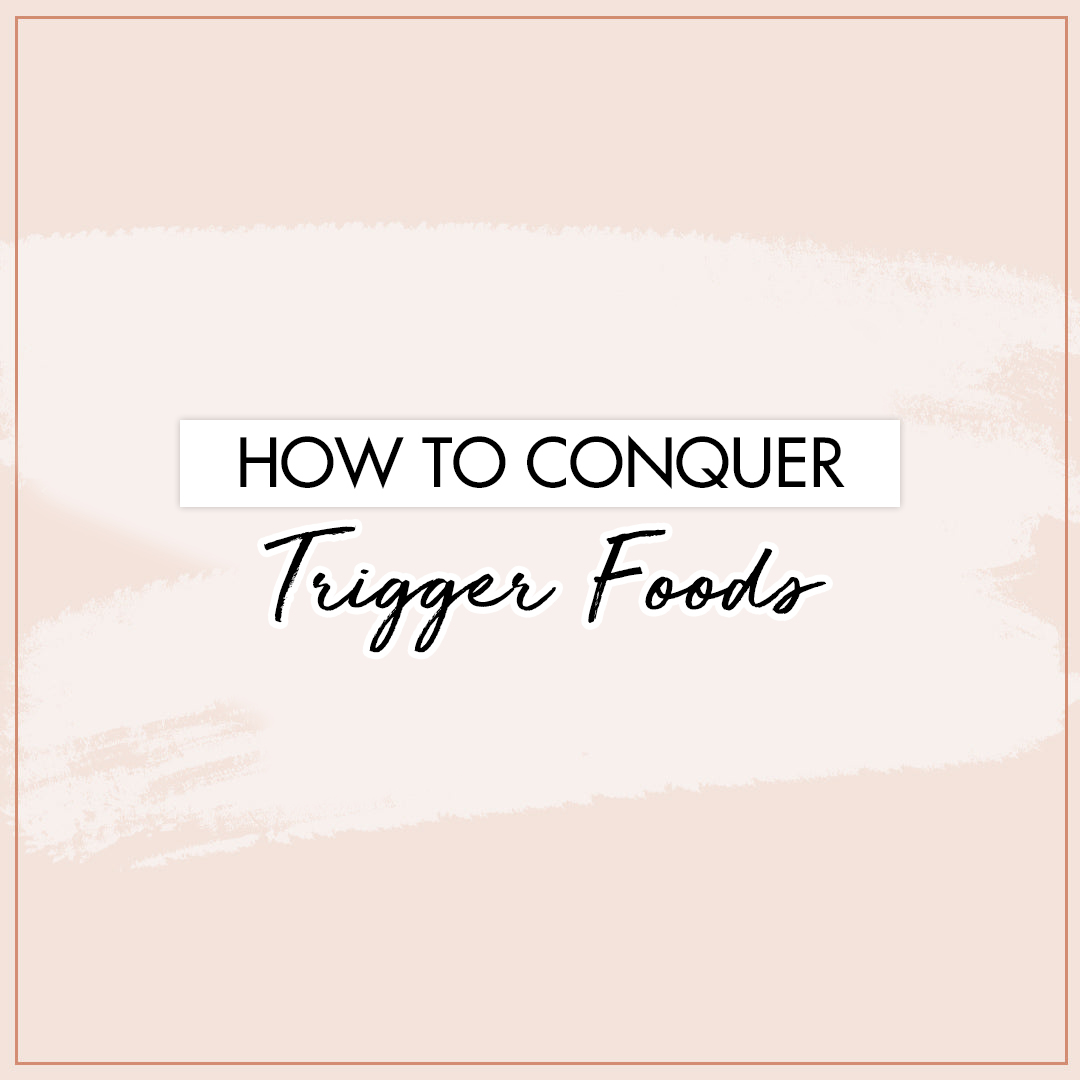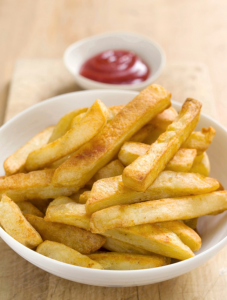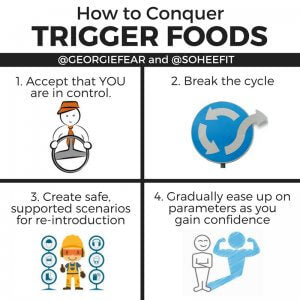How to Conquer Trigger Foods

This is a post that I wrote together with my colleague Georgie Fear. Georgie is a registered dietitian and nutrition coach whose interests align closely with mine. Find her on Facebook and Instagram and check her out at her coaching website!
How many of you have foods that you try to steer clear from because you know – you just know! – that once you start, you can’t stop? Or perhaps you find yourself intentionally seeking that specific food out after a particularly trying day.
A trigger food is a food that you have a difficult time eating a reasonable portion of. Eating a little bit, in other words, usually leads to cleaning off the rest of the plate. These are oftentimes highly palatable foods including chips, cookies, or chocolate. Usually, individuals have an ongoing, tumultuous relationship with said trigger food, and while they may love the taste of it in the moment, it usually doesn’t end well.
Fortunately, it’s entirely possible to conquer trigger foods. Follow this 4-step process below to break free.

1. Accept that you are in control
Forgive the bluntness of this next statement, but it’s crucial to establish as a fact. Your brain controls the movement of your voluntary muscles, so moving your limbs, reaching out to put the food into your mouth, and swallowing it, is your choice. No person or potato chip or slick marketing can take over your limbs and jaws, even if you feel powerless or aren’t aware of your thoughts.
The reason that our sole locus of control is so important to hash out is that the facts can be very different from the way things feel to experience. We can find a lot of evidence (if we look for it) to build a case that we weren’t in control because it felt really compelling to do something. If we regret something after eating it, our natural cognitive protection mechanisms look for a way to not feel as bad, and that can lead to justifications to decrease the amount of responsibility we feel. “I didn’t want to eat the chips, but I just couldn’t help it,” “My brain shuts off when there’s chocolate around”, and the like.

These insinuations that we weren’t in control in the moment do not help you change your behavior. You can’t effectively work on changing something you’re still partially in denial of. And if you’re reading this article, we can conclude you want to know how to change the phenomenon of trigger foods leading to overeating for yourself or someone else.
Commit with us right here that eating is a choice, and it’s a choice we can control. That’s doesn’t mean it’s easy! That doesn’t mean we always choose in line with our values and goals — far from it. It just means we accept our place as Head Honcho of Things Consumed, the most empowered stance to take.
In fact, better to chuck the term “trigger food” altogether. It’s a food you have overeaten in the past. It’s a food you have struggled with moderating, perhaps — but no special status. It’s one of thousands of foods, made of carbon and oxygen and some nitrogen and other chemicals. There’s no wizardry; it’s just ordinary edible stuff, even if you have a bit of checkered history in how you chose to consume it.
2. Break the cycle
Okay, Head Honcho, time to use those executive powers for good. Sounds like there’s a pattern that you’ve picked up on, and that is that your hands + a certain food = a situation that hasn’t ended well. And that’s okay. There’s exactly zero helpfulness in blaming yourself or looking at why, so let’s focus on breaking that pattern. You and your so-called trigger food can always reunite down the road, but a little separation for now will stop the recurring negative experience.
Do you need to get the food out of your kitchen or house? Do you need to chuck it, donate it, or just commit to a week of not seeing each other? Take charge and do it. Break the cycle of hurt and abuse, then you can re-form a healthy relationship.

3. Create Safe, Supported Scenarios for Reintroduction
Think about the negative experiences you had with that specific food in the past. What was going on? Where were you? What were you feeling? What time of day was it? Were you at home, in your car, at the office or your parents’ house? These factors all contribute to the ease or difficulty of eating in line with our values. This means you can engineer an easier scenario by thinking about when and where and with whom you are least likely to overeat a particular food. You don’t want to just rendezvous any old time and place; you want things to be different this time.
Let’s use some examples.
Easier not to overeat ice cream:
I’ve bought a portion from the ice cream shop with my friends, mid-afternoon on Saturday, and I’m walk around the park eating it. What are the odds of going back for seconds? Pretty low. I’d have to go back, wait on line again, make another purchase… and it would be odd to do with the other people around who are doing the usual buy-and-eat-one pattern. If I were trying to establish a healthy moderate relationship with ice cream, this would be a good situation to put together. Invite a couple friends and you could make this happen. In the end, you’re likely to have scored one experience of your eating ice cream in the way you want to. High five.

Now, a situation in which it’s much much harder:
I get pulled over after a stressful day at work, and a rude cop gives me a hefty fine. I get home to see fraudulent charges on my credit card which now I have to deal with also. It’s cold and raining and my husband is away — I feel alone and sad. I have no decent food in the fridge, and there’s a large container of Oreo ice cream in the freezer.
This is not a helpful scenario in which to decide it’s a good time to try eating ice cream again. If you have had difficulty moderating consumption of a particular food, it’s generally not favorable to try and change that when you’re emotional, stressed, not well slept, in the later hours of the day, alone, and have multiple servings in easy reach.
You can control when you choose to have the food again after your break from it. Do it when and where you are feeling assured of your success. Rig the game so you win.
4. Gradually Ease Up On Parameters As You Gain Confidence
Once you’ve had a chance to eat the food and stop at a place you feel good about, it’s not over. It will probably take many repetitions to bolster your confidence that this food is not, in fact, a volition-sapping delicacy.
Keep going. Get those positive experiences in when you are confident it will go your way. And over time, you’ll notice that confidence growing. Maybe after 6 or 7 times having ice cream from the shop with your friends, you feel okay to go on your own and buy a single serving and walk around the park enjoying it. You might not want to jump right away to having 16 flavors at home in bulk supply, so take small steps. You don’t HAVE to keep anything at home, and many people find their peace with sweets and alcohol when they choose to leave them at the store, not bring into their homes.
Consider progressions like this (again, no need to go all the way to the last one if your life is easier without it):
- Having the food with company, out of the house
- Having the food on your own, out of the house
- Having the food with company at home (buying just enough for no leftovers)
- Having the food on your own at home (buying just enough for no leftovers)
- Having the food on your own at home, even if there’s leftovers
Bottom Line:
You are in control of what and how much you eat. If you have particular difficulty with a certain food, that’s normal and not permanent. You can change that. Start with a commitment to stop repeating what isn’t working so you don’t keep rehearsing the overeating experience with that food. Take a break from the food long enough to think of a specific situation in which you are darned sure you will not (even cannot) overeat it. When you’d like to have the food again, have it under your terms. Keep the supports in place to rack up many experiences where you eat that food in a way you are happy with. Ease off the supports if you feel you don’t need them any longer, but keep the ones which make your life easiest.
Here’s a summary graphic to help keep it all fresh in your mind:

There are no medals for withstanding temptation, so consider it your lifetime right to choose where, when and how you meet particularly tempting foods.




